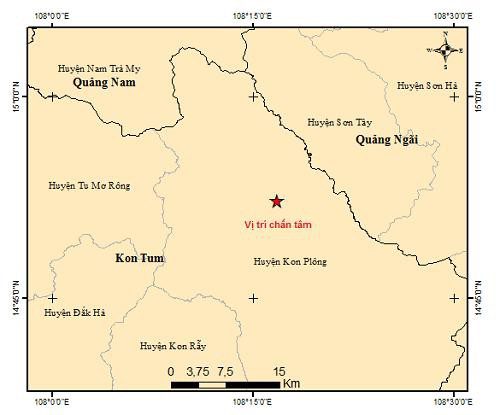On April 17, another earthquake struck Kon Plong District in Kon Tum Province (Central Highlands). This marks the 10th earthquake in the area over the past two days and one of dozens of earthquakes that have occurred in this region since last year.
The most recent earthquake occurred at 00:43:50 (Hanoi time) on April 17, with a magnitude of 2.8 at coordinates (14.906° N, 108.161° E), with an epicenter depth of approximately 10 km. The earthquake struck within Kon Plong District, Kon Tum Province.

Earthquake area in the Central Highlands.
Previously, on April 15-16, Kon Plong District experienced a total of 9 earthquakes, the most significant being one that occurred at 20:47:57 (Hanoi time) on April 15, with a magnitude of 4.1 and an epicenter depth of approximately 8.1 km.
In fact, earthquakes in Kon Plong District and its neighboring districts in Kon Tum Province have been reported since April 2021, with some days recording multiple earthquakes.
Explaining the reason for the surge in earthquakes in this area, which has historically seen few seismic activities, Associate Professor Dr. Cao Dinh Trieu, an earthquake expert, suggested that the cause could be induced seismicity related to the operation of hydroelectric reservoirs. Notably, on March 24, 2021, the Thượng Kon Tum Hydropower Plant in Kon Plong District began operations and generated power from Unit 1.
Associate Professor Cao Dinh Trieu further noted that the earthquake zone is situated on an active fault line known as the Rào Quán – A Lưới fault, which is a strong fault zone extending from Laos, through A Lưới, and down to Quy Nhon.
Induced earthquakes have previously been recorded along this fault line at the Song Tranh 2 Hydropower Plant (Quang Nam) and the Đak Drinh Hydropower Plant (Quang Ngai) when these facilities were filling their reservoirs.
At the Song Tranh 2 Hydropower Plant, earthquakes have been occurring since 2011, with the strongest reaching a magnitude of 4.7, causing significant concern and disruption in the lives of residents in Bac Tra My and Nam Tra My districts (Quang Nam Province). In contrast, the induced earthquakes at the Đak Drinh Hydropower Plant were shorter in duration, with lower intensity and frequency.
According to Associate Professor Cao Dinh Trieu, the induced earthquakes along the same fault line can vary by region. Therefore, for the area experiencing earthquakes in Kon Tum currently, thorough surveys and assessments are necessary.





















































